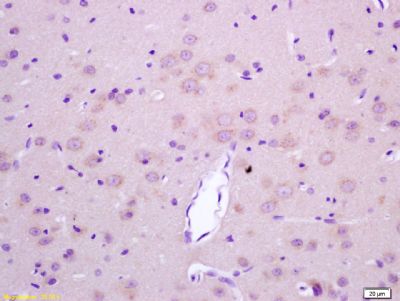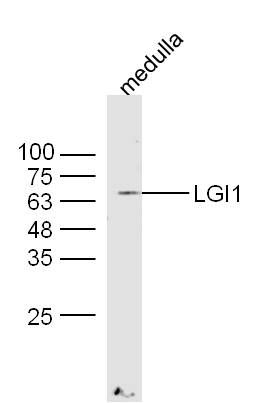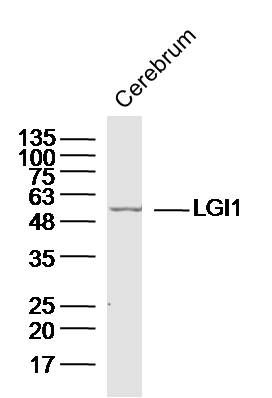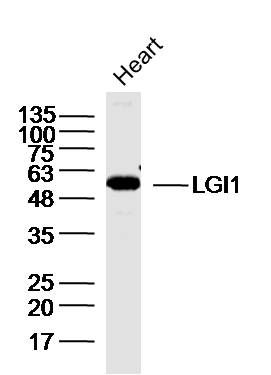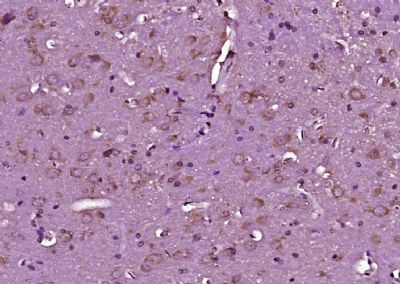LGI1 Polyclonal Antibody
Purified Rabbit Polyclonal Antibody (Pab)
- SPECIFICATION
- CITATIONS
- PROTOCOLS
- BACKGROUND

Application
| WB, IHC-P, IHC-F, IF, E |
|---|---|
| Primary Accession | O95970 |
| Reactivity | Rat, Pig, Dog, Bovine |
| Host | Rabbit |
| Clonality | Polyclonal |
| Calculated MW | 64 KDa |
| Physical State | Liquid |
| Immunogen | KLH conjugated synthetic peptide derived from human LGI1/ETL1 |
| Epitope Specificity | 451-557/557 |
| Isotype | IgG |
| Purity | affinity purified by Protein A |
| Buffer | 0.01M TBS (pH7.4) with 1% BSA, 0.02% Proclin300 and 50% Glycerol. |
| SUBCELLULAR LOCATION | Secreted. Cell junction, synapse (By similarity). Note=Isoform 1 but not isoform 2 is secreted. Isoform 1 is enriched in the Golgi apparatus while isoform 2 accumulates in the endoplasmic reticulum. |
| SIMILARITY | Contains 7 EAR repeats.Contains 3 LRR (leucine-rich) repeats.Contains 1 LRRCT domain.Contains 1 LRRNT domain |
| SUBUNIT | Oligomer (By similarity). Interacts with KCNA1 within a complex containing KCNA1, KCNA4 and KCNAB1 (By similarity). Part of a complex containing ADAM22, DLG4/PSD95 and CACNG2 (stargazin) (By similarity). Can bind to ADAM11 and ADAM23 (By similarity). |
| Post-translational modifications | Glycosylated. |
| DISEASE | Defects in LGI1 are the cause of lateral temporal lobe epilepsy autosomal dominant (ADLTE) [MIM:600512]; also known as autosomal dominant partial epilepsy with auditory features (ADPEAF). ADLTE is a form of epilepsy characterized by partial seizures, usually preceded by auditory signs. |
| Important Note | This product as supplied is intended for research use only, not for use in human, therapeutic or diagnostic applications. |
| Background Descriptions | Regulates voltage-gated potassium channels assembled from KCNA1, KCNA4 and KCNAB1. It slows down channel inactivation by precluding channel closure mediated by the KCNAB1 subunit. Ligand for ADAM22 that positively regulates synaptic transmission mediated by AMPA-type glutamate receptors (By similarity). Plays a role in suppressing the production of MMP1/3 through the phosphatidylinositol 3-kinase/ERK pathway. May play a role in the control of neuroblastoma cell survival. Tissue specificity;Predominantly expressed in neural tissues, especially in brain. Expression is reduced in low-grade brain tumors and significantly reduced or absent in malignant gliomas. Isoform 1 is absent in the cerebellum and is detectable in the occipital cortex and hippocampus; higher amounts are observed in the parietal and frontal cortices, putamen, and, particularly, in the temporal neocortex, where it is 3.5 times more abundant than in the hippocampus (at protein level). Isoform 3 shows the highest expression in the occipital cortex and the lowest in the hippocampus (at protein level). |
| Gene ID | 9211 |
|---|---|
| Other Names | Leucine-rich glioma-inactivated protein 1, Epitempin-1, LGI1, EPT |
| Target/Specificity | Predominantly expressed in neural tissues, especially in brain. Expression is reduced in low-grade brain tumors and significantly reduced or absent in malignant gliomas. Isoform 1 is absent in the cerebellum and is detectable in the occipital cortex and hippocampus; higher amounts are observed in the parietal and frontal cortices, putamen, and, particularly, in the temporal neocortex, where it is 3.5 times more abundant than in the hippocampus (at protein level). Isoform 3 shows the highest expression in the occipital cortex and the lowest in the hippocampus (at protein level). |
| Dilution | WB=1:500-2000,IHC-P=1:100-500,IHC-F=1:100-500,IF=1:100-500,ELISA=1:5000-10000 |
| Format | 0.01M TBS(pH7.4), 0.09% (W/V) sodium azide and 50% Glyce |
| Storage | Store at -20 ℃ for one year. Avoid repeated freeze/thaw cycles. When reconstituted in sterile pH 7.4 0.01M PBS or diluent of antibody the antibody is stable for at least two weeks at 2-4 ℃. |
| Name | LGI1 |
|---|---|
| Synonyms | EPT |
| Function | Regulates voltage-gated potassium channels assembled from KCNA1, KCNA4 and KCNAB1. It slows down channel inactivation by precluding channel closure mediated by the KCNAB1 subunit. Ligand for ADAM22 that positively regulates synaptic transmission mediated by AMPA-type glutamate receptors (By similarity). Plays a role in suppressing the production of MMP1/3 through the phosphatidylinositol 3-kinase/ERK pathway. May play a role in the control of neuroblastoma cell survival. |
| Cellular Location | Secreted. Synapse {ECO:0000250|UniProtKB:Q8K4Y5}. Cytoplasm {ECO:0000250|UniProtKB:Q9JIA1} [Isoform 2]: Endoplasmic reticulum. Cytoplasm {ECO:0000250|UniProtKB:Q9JIA1} |
| Tissue Location | Predominantly expressed in neural tissues, especially in brain. Expression is reduced in low-grade brain tumors and significantly reduced or absent in malignant gliomas [Isoform 3]: Abundantly expressed in the occipital cortex and weakly expressed in the hippocampus (at protein level) |

Thousands of laboratories across the world have published research that depended on the performance of antibodies from Abcepta to advance their research. Check out links to articles that cite our products in major peer-reviewed journals, organized by research category.
info@abcepta.com, and receive a free "I Love Antibodies" mug.
Provided below are standard protocols that you may find useful for product applications.
If you have used an Abcepta product and would like to share how it has performed, please click on the "Submit Review" button and provide the requested information. Our staff will examine and post your review and contact you if needed.
If you have any additional inquiries please email technical services at tech@abcepta.com.













 Foundational characteristics of cancer include proliferation, angiogenesis, migration, evasion of apoptosis, and cellular immortality. Find key markers for these cellular processes and antibodies to detect them.
Foundational characteristics of cancer include proliferation, angiogenesis, migration, evasion of apoptosis, and cellular immortality. Find key markers for these cellular processes and antibodies to detect them. The SUMOplot™ Analysis Program predicts and scores sumoylation sites in your protein. SUMOylation is a post-translational modification involved in various cellular processes, such as nuclear-cytosolic transport, transcriptional regulation, apoptosis, protein stability, response to stress, and progression through the cell cycle.
The SUMOplot™ Analysis Program predicts and scores sumoylation sites in your protein. SUMOylation is a post-translational modification involved in various cellular processes, such as nuclear-cytosolic transport, transcriptional regulation, apoptosis, protein stability, response to stress, and progression through the cell cycle. The Autophagy Receptor Motif Plotter predicts and scores autophagy receptor binding sites in your protein. Identifying proteins connected to this pathway is critical to understanding the role of autophagy in physiological as well as pathological processes such as development, differentiation, neurodegenerative diseases, stress, infection, and cancer.
The Autophagy Receptor Motif Plotter predicts and scores autophagy receptor binding sites in your protein. Identifying proteins connected to this pathway is critical to understanding the role of autophagy in physiological as well as pathological processes such as development, differentiation, neurodegenerative diseases, stress, infection, and cancer.
